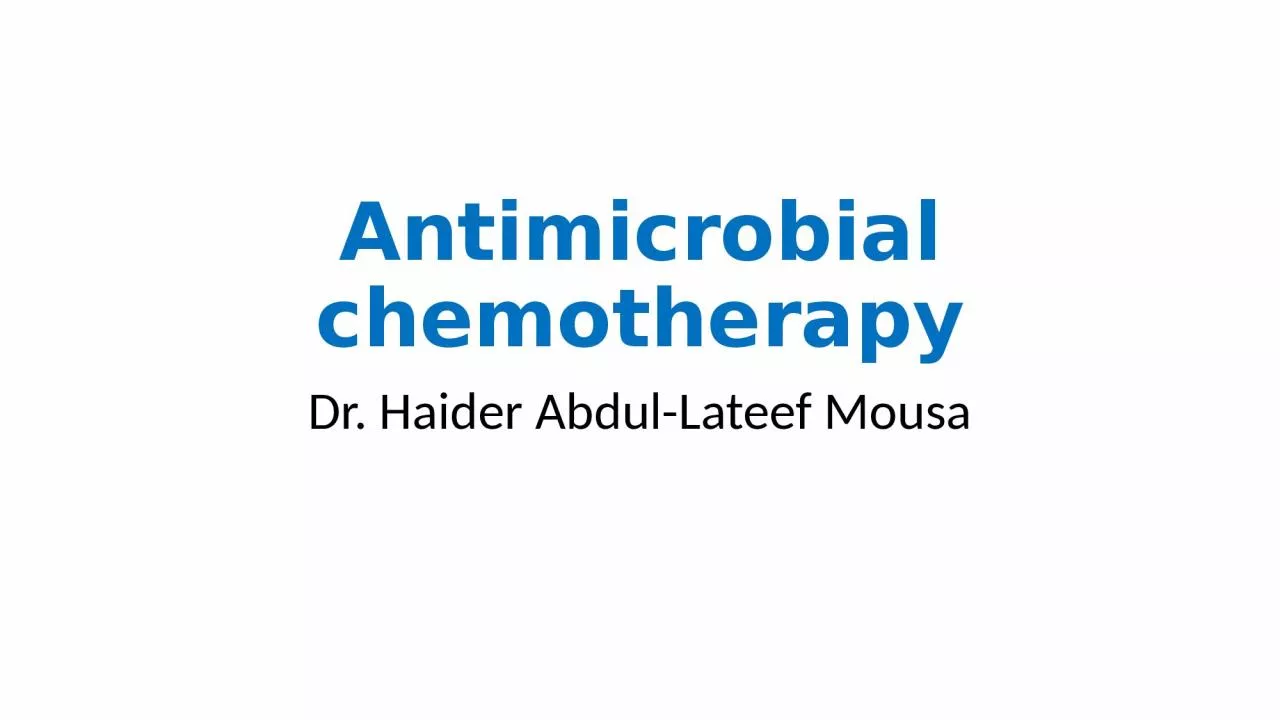

Dr Haider AbdulLateef Mousa Learning Objectives To understand how antibiotics work To review how drug resistance develops in bacteria T o summarize current status of antimicrobial resistance in selected bacteria ID: 1033667
Download Presentation The PPT/PDF document "Antimicrobial chemotherapy" is the property of its rightful owner. Permission is granted to download and print the materials on this web site for personal, non-commercial use only, and to display it on your personal computer provided you do not modify the materials and that you retain all copyright notices contained in the materials. By downloading content from our website, you accept the terms of this agreement.
1. Antimicrobial chemotherapyDr. Haider Abdul-Lateef Mousa
2. Learning Objectives•To understand how antibiotics work• To review how drug resistance develops in bacteria• T o summarize current status of antimicrobial resistance in selected bacteria• To understand how resistant organisms are detected in the clinical laboratory
3. Antimicrobial chemotherapy is the clinical application of antimicrobial agents to treat infectious disease.There are five types of antimicrobial chemotherapy:1. Antibacterial chemotherapy, the use of antibacterial drugs to treat bacterial infections2. Antifungal chemotherapy, the use of antifungal drugs to treat fungal infections3. Anthelminthic chemotherapy, the use of antihelminthic drugs to treat worm infections4. Antiprotozoal chemotherapy, the use of antiprotozoal drugs to treat protozoan infections5. Antiviral chemotherapy, the use of antiviral drugs to treat viral infections
4. Terminology• Antimicrobial drugs - Interfere with the growth of microbes within a host.• Antibiotic - Of biological origin. Produced by a microbe, inhibits other microbes (penicillin). Can be modified to enhance efficacy (semisynthetic).• Chemotherapeutic agent - Synthetic chemicals (Sulfa drugs).• Antiseptic – An agent used to inhibit or eliminate microbes on skin or other living tissue (alcohol, iodine, chlorhexidine)• Disinfectant – An agent used to destroy microbes on inanimate objects (phenols, formaldehyde, chlorine)
5. The susceptibility of microbes to different antibiotics varies greatlyGram-positive and gram-negative bacteria vary in their sensitivity to antibiotics Broad-spectrum antibiotics are effective against both groups of bacteria
6. Features of Antimicrobial DrugsSelective toxicity: Drug kills pathogens without damaging the host.Therapeutic index: ratio between toxic dose and therapeutic dose – High therapeutic index less toxicAntimicrobial action – Bacteriostatic vs. bactericidalActivity Spectrum – Broad-spectrum vs. narrow- spectrumTissue distribution, metabolism, and excretion – Unstable in acid; half-life duration
7. The Action of Antimicrobial Drugs
8. Classification of Antibioticsby Mechanism of ActionInhibition of cell wall synthesisBeta-lactam drugsPenicillinsCephalosporinsCarbapenemsThe othersCycloserineVancomycinbacitracin
9. Antibacterial mechanism of β-lactams
10. Disruption of cell membranesPolymyxinPolyenes (anti-fungal agents)
11. Inhibition of protein synthesisReversible inhibition (bacteriostatic)ChloramphenicolThe tetracyclinesThe macrolides (erythromycin)ClindamycinStreptograminsLinezolidIrreversible – the bactericidal aminoglycosides
12. -Lactam Antibiotics: Penicillins and Cephalosporins-Lactam antibiotics are one of the most important groups of antibiotics of all timeInclude penicillins, cephalosporins, and cephamycinsOver half of all antibiotics used worldwidePenicillins Discovered by Alexander Fleming in1928.Primarily effective against gram-positive bacteriaSome synthetic forms are effective against some gram-negative bacteriaTarget cell wall synthesisCephalosporins Produced by fungus CephalosporiumSame mode of action as the penicillins
13. Antibacterial AntibioticsInhibitors of Cell Wall Synthesis: PenicillinNatural and semisynthetic penicilins contain β-lactam ringNatural penicillins produced by Penicillium are effective against Gram + cocci and spirochetesSemisynthetic penicillins: made in laboratory by adding different side chains onto β-lactam ring penicillinase resistant and broader spectrum of activity
14. Penicillinase (β-lactamase): bacterial enzyme that destroys natural penicillinsPenicillinase resistant penicillins: methicilin replaced by oxacilin and nafcilin due to MRSAExtended-spectrum penicilins: Ampicilin, amoxicilin; new: carboxypenicilins and ureidopenicillins (also good against P. aeruginosa)
15. CephalosporinsProduced by Fungi of genus Cephalosporium 4 Generations of cephalosporins.First-generation: Narrow spectrum, gram-positiveSecond-generation: Extended spectrum includes gram-negativeThird-generation: Includes pseudomonads; mostly injected, some oral.Fourth-generation: Most extended spectrum
16. Cephalosporins cont.Structure and mode of action resembles penicilinsMore stable to bacterial -lactamases than penicilins Broader spectrum used against penicillin-resistant strains
17. VancomycinGlycopeptide from StreptomycesInhibition of cell wall synthesisUsed to kill MRSA (Methicillin-resistant Staphylococcus aureus)
18. Antibiotics from ProkaryotesMany antibiotics effective against Bacteria are also produced by BacteriaAminoglycosides are antibiotics that contain amino sugars bonded by glycosidic linkageExamples: Gentamicin, kanamycin, neomycin, amikacinNot commonly used todayNeurotoxicity and nephrotoxicityConsidered reserve antibiotics for when other antibiotics fail
19. Antibiotics from Prokaryotes, cont.Macrolides contain lactone rings bonded to sugarsExample: erythromycinBroad-spectrum antibiotic that targets the 50S subunit of ribosomeTetracyclines contain four ringsWidespread medical use in humans and animalsBroad-spectrum inhibition of protein synthesisInhibits functioning of 30S ribsomal subunit
20. Antifungal DrugsPolyenes, such as nystatin and amphotericin B, for systemic fungal infections. Inhibition of ergosterol synthesis fungicidal. NephrotoxicGriseofulvin from Penicillium. Systemic/oral. Binds to tubulin For Tineae
21. Antiviral DrugsNucleoside analogs inhibit DNA synthesisAcyclovir and newer derivatives: Selective inhibition of herpes virus replication. Acyclovir conversion to nucleotide analog only in virus infected cells very little harm to uninfected cells!Oseltamivir (Tamiflu) is an antiviral medication used to treat and prevent influenza A and influenza B. It is a neuraminidase inhibitor, a competitive inhibitor of influenza's neuraminidase enzyme.Paxlovid (nirmatrelvir tablets and ritonavir tablets), and molnupiravir used for the treatment of mild-to-moderate coronavirus disease (COVID-19).
22. Antiprotozoan and Antihelminthic DrugsExamples of Antiprotozoan:Chloroquine: MalariaQuinacrine: GiardiaMetronidazole (Flagyl): Entamoeba histolytica, Vaginitis, anaerobic bacteria Examples of Antihelminthic: Niclosamide and praziquantel: Tapeworm Mebendazole: broadspectrum antihelminticIvermectin: nematodes, mites, lice . . .
23. Antibiotic Assays to Guide Chemotherapy Agar Disk Diffusion Method determines susceptibility of an organism to a series of antibiotics: Kirby-Bauer testDilution Susceptibility Tests: Minimal inhibitory conc. ( MIC ) – Lowest conc. of a drug that ↓ bacterial growth .Measurement of Drug Concentration in the Blood
24. THANK YOU